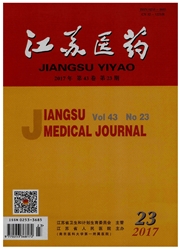

 中文摘要:
中文摘要:
目的探讨脊髓水平细胞外信号调节蛋白激酶5(extra—cellular signal-regulated protein kinase5,ERK5)在大鼠吗啡戒断行为中的作用。方法成年雄性SD大鼠96只,体质量200~250g,采用随机数字法,将其分为4组(每组n=24):生理盐水一纳洛酮-DMSO组(A组)、生理盐水一纳洛酮一BIX02188组(B组)、吗啡一纳洛酮一DMSO组(C组)、吗啡一纳洛酮一BIX02188组(D组)。采用剂量递增法皮下注射吗啡以建立大鼠吗啡依赖模型,第6天上午经腹腔注射纳洛酮,催促戒断症状出现,即建立吗啡戒断模型。结合药理学手段鞘内注射ERK5特异性抑制剂BIX02188,观察其对吗啡依赖大鼠戒断行为及戒断所致的痛觉过敏的影响。结果A、B两组大鼠腹腔注射纳洛酮后并未出现戒断症状及痛觉过敏。与A组相比,C组大鼠戒断后咬牙(7.5±1.1)分、湿狗样抖动(4.6+0.7)分、戒断后跳跃(5.3+0.7)分、扭体(8.9±I.9)分、腹泻(7.1±1.6)分、流涎(2.8+0.6)分、体质量减轻(7.9+0.9)分、戒断症状总评分(44.8+5.9)分、痛觉过敏评分(14.6±2.4)分及D组大鼠戒断后咬牙(3.1±0.5)分、湿狗样抖动(1.5+0.D)分、戒断后跳跃(2.2+0.5)分、扭体(7.9±1.6)分、腹泻(1.8+0.5)分、流涎(2.8+0.9)分、体质量减轻(3.7±0.6)分、戒断症状总评分(23.1±1.3)分、痛觉过敏评分(3.5±1.1)分明显增加(P〈O.05);与C组相比,D组大鼠鞘内注射BIX02188后戒断症状如咬牙(3.1±0.5)分、湿狗样抖动(1.50.4)分、戒断后跳跃(2.2±0.5)分、腹泻(1.8+0.5)分、体质量减轻(3.70.6)分、戒断症状总评分(23.1±I.3)分、痛觉过敏评分(3.5±1.1)分明显得到缓解(P〈0.05);而扭体(7.9±1.6)分及流涎(2.80.9)分并未得到缓解
 英文摘要:
英文摘要:
Objective To investigate the roles of spinal extracellular signal-regulated protein kinases 5 (ERK5) on morphine withdrawal in rats. Methods Ninety-six male and adult SD rats weighting 230-250 g were randomly divided into saline-naloxone-DMSO group (group A) , saline-naloxone-BIX02188 group (group B) , mor- phine-naloxone-DMSO group (group C) and morphine-naloxone-BIX02188 group (group D). To set up morphine dependent model ,rats were subcutaneously injected with morphine in the increasing dosage method. On day 6,4 h after the injection of morphine, rats were injected with naloxone (intraperitoneal) to precipitate morphine withdraw- al syndrome. The scores of morphine withdrawal symptom and morphine withdrawal-induced allodynia were ob- served after intratheeal injection of ERK5 inhibitor BIX02188. Result There were not withdrawal symptoms and withdrawal-induced allodynia in group A and B after intraperitoneal injection of naloxone. Compared with group A, teeth chatting ( 7.5 ~ 1.1 ), wet dog shacks ( 4.6 ± 0.7 ), jump ( 5.3 ± 0.7 ), abnormal position ( 8.9 ± 1.9 ), diarrhea ( 7.1 ± 1.6 ) , salivation ( 2.8 ± 0.6 ), weight loss ( 7.9 ± 0.9 ) , total withdrawal score ( 44.8 ± 5.9 ), score of withdrawal- induced allodynia (14.6±2.4) of group C and teeth chatting ( 3.1 ±0.5), wet dog shacks ( 1.5±0.4), jump ( 2.2± 0.5 ), abnormal position ( 7.9± 1.6), diarrhea ( 1.8±0.5 ), salivation ( 2.8±0.9), weight loss ( 3.7±0.6), total with- drawal score ( 23.1 ± 1.3) and score of withdrawal-induced allodynia ( 3.5 ± 1.1 ) of group D were significantly in- creased (P〈0.05). Compared with, group C ,teeth chatting (3.1~0.5) ,wet dog shacks (1.5±0.4) ,jump (2.2~0.5) ,diarrhea (1.8-±0.5) ,weight loss (3.7~0.6) and total withdrawal score (23.1~1.3),score of withdrawal-induced allodynia (3.5~ 1.1) of group D were significantly decreased (/o〈0.05). But there was not significant cha
 同期刊论文项目
同期刊论文项目
 同项目期刊论文
同项目期刊论文
 Activation of the spinal extracellular signal-regulated kinase 5 signaling pathway contributes to mo
Activation of the spinal extracellular signal-regulated kinase 5 signaling pathway contributes to mo Activation of peripheral ephrinBs/EphBs signaling induces hyperalgesia through a MAPKs-mediated mech
Activation of peripheral ephrinBs/EphBs signaling induces hyperalgesia through a MAPKs-mediated mech Calbindin-D28K expression induced by glial cell line-derived neurotrophic factor in substantia nigra
Calbindin-D28K expression induced by glial cell line-derived neurotrophic factor in substantia nigra Involvement of the nitric oxide-cyclic GMP-protein kinase G-K+ channel pathway in the antihyperalges
Involvement of the nitric oxide-cyclic GMP-protein kinase G-K+ channel pathway in the antihyperalges Expression of drebrin in the distal cerebrospinal fluid contacting neurons of rats with chronic cons
Expression of drebrin in the distal cerebrospinal fluid contacting neurons of rats with chronic cons Distribution and effects of 5-HT(1A) receptors in distal cerebral spinal fluid-contacting neurons in
Distribution and effects of 5-HT(1A) receptors in distal cerebral spinal fluid-contacting neurons in The activation of extracellular signal-regulated protein kinase 5 in spinal cord and dorsal root gan
The activation of extracellular signal-regulated protein kinase 5 in spinal cord and dorsal root gan 期刊信息
期刊信息
